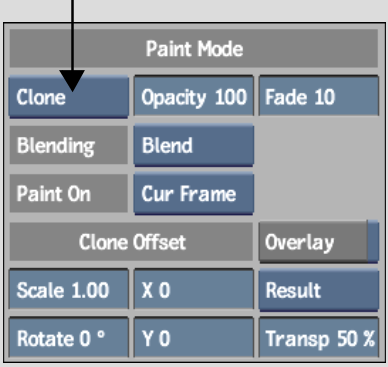Show in Contents

Add to Favorites

Home: Flint

Smear

Using Paint Modes

Recursive Clone

Clone
Use the Clone tool to paint a copy of
the result image to any position on the result image. The Clone
tool can also be applied to an output matte image. For example,
if the result image has a tree that you would like to copy to another
position on the image, you can offset a copy of it to a different
position and then paint it onto the result.
To paint a source onto the canvas, use the Reveal
tool. See
Revealing Sources.
To clone an image and include cloned data in
the brush strokes, use the Recursive Clone tool. See
Recursive Clone.
NoteIf changes are made upstream of the Paint
node, cloned strokes are preserved. However, the strokes will reflect
the “old” input unless you force an update by
clicking the Update button or by pressing U.
Updates are not performed automatically because they can affect
system performance.
To
clone an image:
- Select
Clone from the Paint Modes box (or press W).
The Clone Offset parameters appear.
- Set
brush attributes. See
Brush Attributes and Attribute Modes.
- To
limit the cloned regions to the areas delimited by the matte, select
an option in the Matte Source box.
- To
transform the reference image, do one of the following:
- To
manually offset the image, enable the Overlay button (Tab), then hold down Ctrl+Shift and
drag the overlaid reference image.
- To
scale the image, enter a value in the Scale field.
- To
rotate the image, enter the angle of rotation in the Rotate field.
NoteTo select an area for cloning, Overlay must
be turned off. If you offset an image, verify that the Overlay button
is disabled after use.
- To
select the area you want to clone, press Ctrl and
click the canvas.
The cursor turns red when you press Ctrl. When you click the canvas,
the red cursor is anchored and a green cursor appears.
- Position
the green cursor over the destination area and click the canvas.
The green and red cursors are now locked into
positions relative to each other and move in tandem.
- To
set precise coordinates for the clone offset, use the X and Y fields.
- Click
and drag on the canvas to clone to the destination area.


